Snakes are some of the most common animals in the US, with approximately 100 species living across the country. There are 18 species in Michigan and these can be found in a wide variety of habitats. However, as Michigan is part of the Great Lakes region, it is the perfect spot for water snakes to live. So, read on to discover the water snakes in Michigan. We’ll find out what they look like and what type of aquatic habitat they prefer.
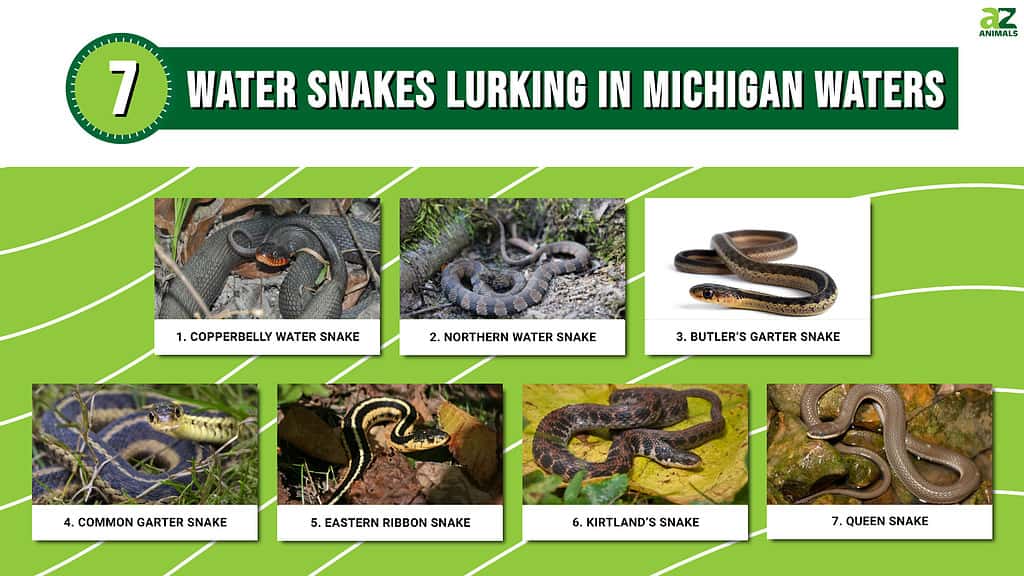
1. Copperbelly Water Snake (Nerodia erythrogaster neglecta)
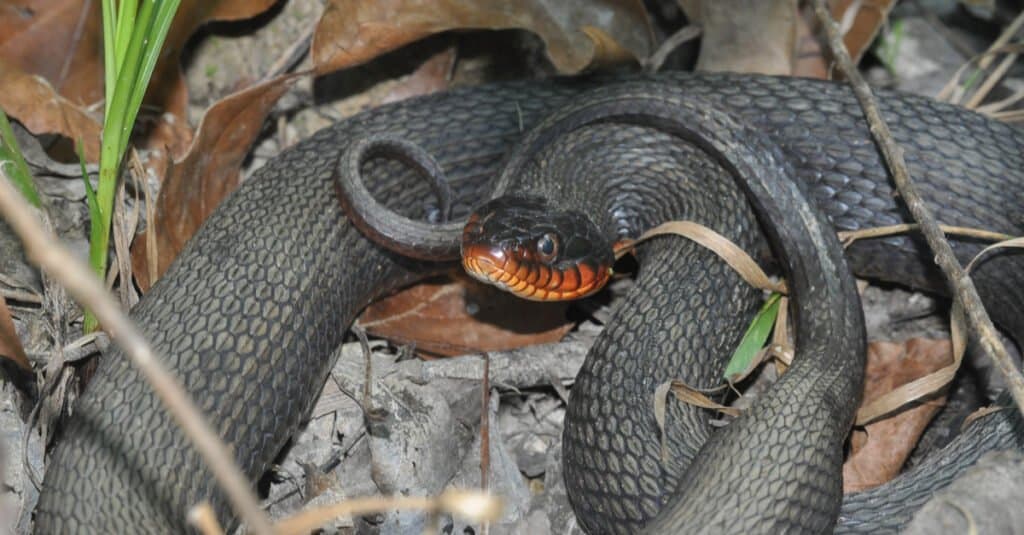
Copperbelly water snakes have a distinctive reddish-orange belly.
©Mike Wilhelm/Shutterstock.com
The copperbelly water snake is a subspecies of the plain-bellied water snake. Copperbelly water snakes are only found in the southern region of the state and are state endangered. They typically inhabit slow-moving bodies of water, such as swamps and streams, and prey on fish, frogs, tadpoles, and salamanders. Copperbelly water snakes are three to five feet long and are dark brown to black with reddish-colored bodies. Juveniles are approximately six inches long when they are born and have reddish-brown crossbands with light orange bellies and an orange chin and lips.
2. Northern Water Snake (Nerodia sipedon)
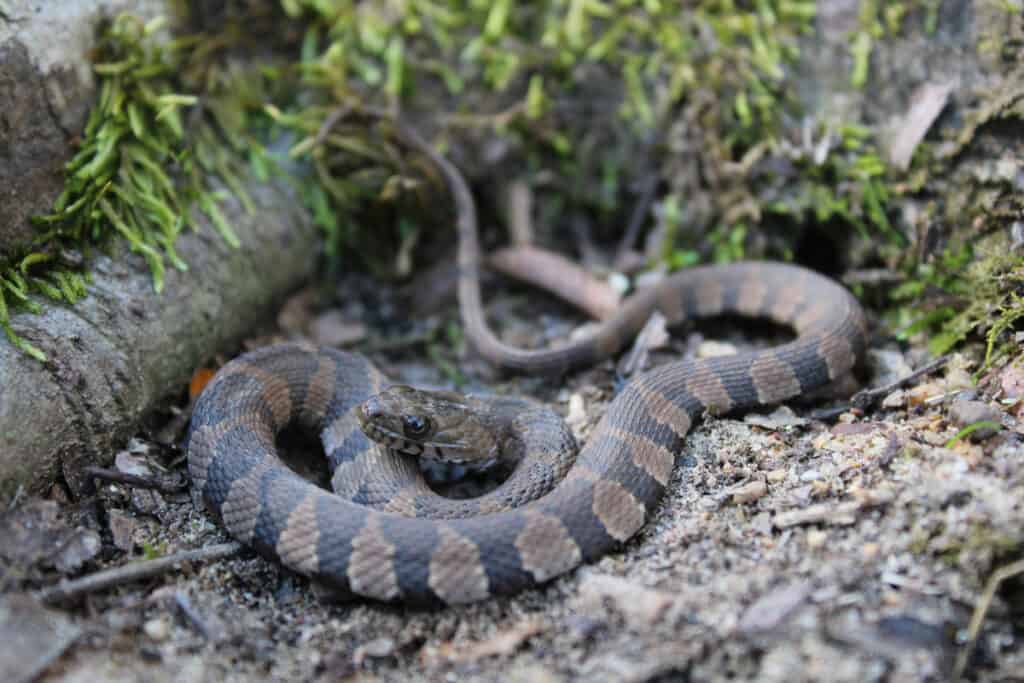
Northern water snakes have an anticoagulant in their saliva which means wounds inflicted by them tend to bleed a lot.
©Tucker Heptinstall/Shutterstock.com
The northern water snake is one of the biggest water snakes in Michigan approximately five feet long. Northern water snakes are brown with dark brown markings, consisting of crossbands that transition to blotches as they near their tail. Northern water snakes are powerful animals that can live in most freshwater habitats. They do not usually stray far from water and can sometimes be spotted basking on rocks near the water’s edge or hanging from branches nearby. Northern water snakes mainly prey on fish and amphibians, although they may also eat small birds and mammals. They are not venomous, but they can still be dangerous. This is because they are extremely defensive and may strike if they are threatened. Bites from these snakes often bleed a lot because they have an anticoagulant in their saliva which stops blood from clotting.
3. Butler’s Garter Snake (Thamnophis butleri)
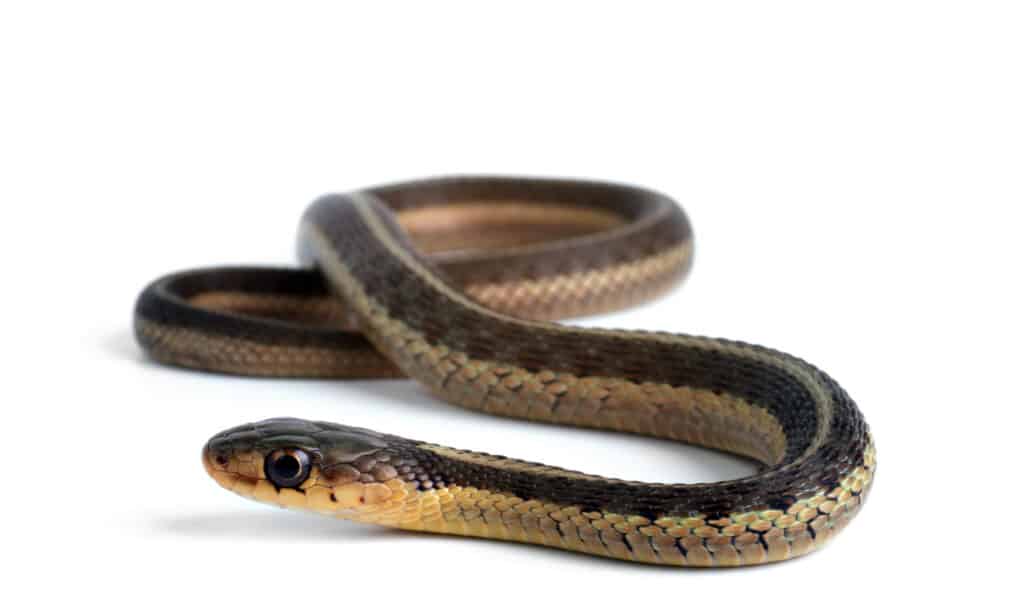
Butler’s garter typically lives in wetland areas, such as streams, marshes, and wet meadows.
©Michiel de Wit/Shutterstock.com
The first of two garter snakes in the state is Butler’s garter snake. Butler’s garter snakes are a species of special concern in the state and mainly only inhabit the Lower Peninsula. Although they can sometimes be found in urban areas, they typically prefer to live in wetland areas, such as wet meadows, marshes, streams, and ponds. Butler’s garter snakes are only 15 to 20 inches long and have brown to black bodies. They also have three yellow or orange stripes. One is in the center of their back, while the other two are located on the third row of scales on each side of their body. However, these stripes also overlap in the second and fourth rows. They mainly eat earthworms and leeches, although they may also sometimes eat small fish.
4. Common Garter Snake (Thamnophis sirtalis)
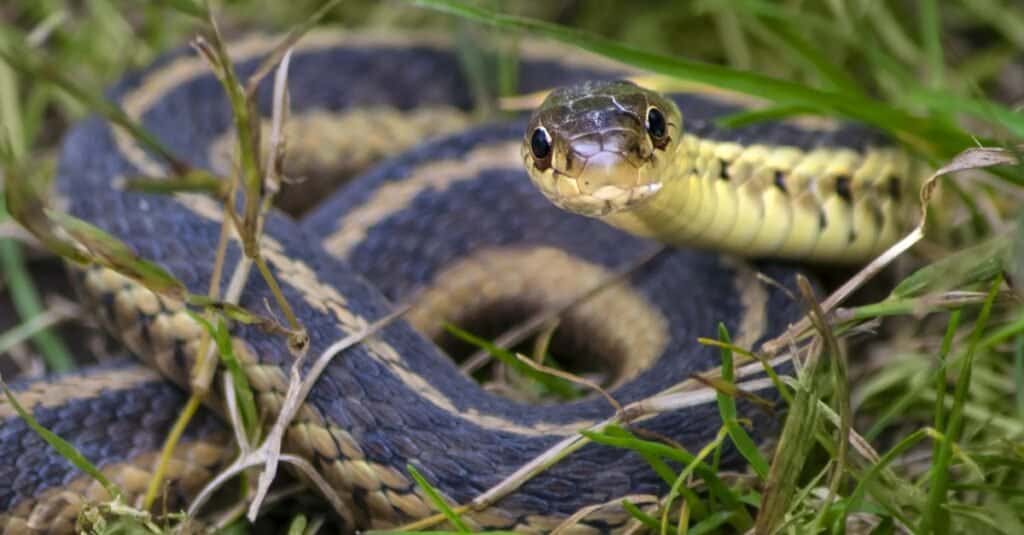
Common garter snakes are harmless to people but have mildly venomous saliva.
©K Quinn Ferris/Shutterstock.com
The next water snake in Michigan is another garter snake. Common garter snakes are widespread across the state and can live in a wide variety of habitats. However, they are often closely associated with water and frequently live close to swamps, lakes, ponds, and rivers. They are excellent swimmers and often head into the water at the first sign of a threat. Common garter snakes prey on a range of fish and amphibians, as well as birds and small mammals. They are not dangerous to humans, but they are technically venomous to their prey as they have venomous saliva. This venomous substance is produced in the Durvenoy gland and is chewed into its prey instead of being injected.
5. Eastern Ribbon Snake (Thamnophis saurita)
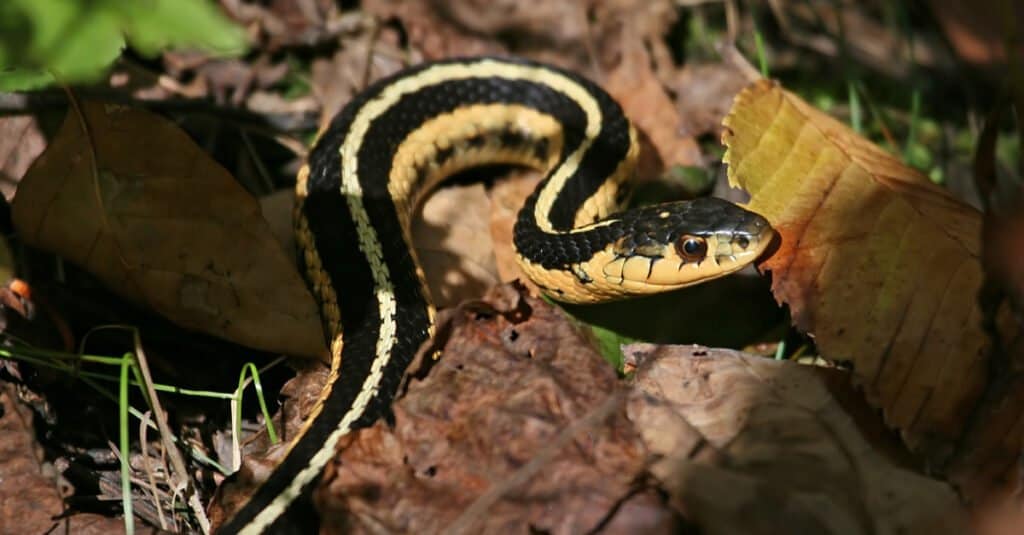
The northern ribbon snake is the subspecies that live in Michigan.
©John Czenke/Shutterstock.com
The eastern ribbon snake is another snake that can live in a variety of locations but is often found close to water, particularly around streams, swamps, and ponds. The northern subspecies is the subspecies that is typically found in Michigan and is a species of greatest conservation need within the state. They are 18 to 26 inches long and have dark brown to black bodies with three yellow stripes and a yellowish-colored belly. Juveniles are seven to nine inches long when they are born and have a similar coloration to adults, although their belly is usually a little paler. Eastern ribbon snakes are not dangerous to humans. They prey mainly on amphibians which they swallow alive.
6. Kirtland’s Snake (Clonophis kirtlandii)

Kirtland’s snakes can be distinguished by the large blotches on their bodies.
©Mike Wilhelm/Shutterstock.com
Another water snake in Michigan with a limited range is Kirtland’s snake which inhabits only the southern region and is state endangered. Kirtland’s snakes are also sometimes called Kirtland’s water snakes due to their semi-aquatic nature. They almost always live close to a source of water, with swamps and marshes being their preferred habitats. Kirtland’s water snakes are the smallest species on this list, being only 12 to 18 inches long. They are reddish to dark brown with four rows of blotches on their back and sides. They are not venomous and when threatened they tend to either hide or flee. Kirtland’s snakes mainly prey on slugs and earthworms, but also sometimes eat amphibians, salamanders, and leeches.
7. Queen Snake (Regina septemvittata)
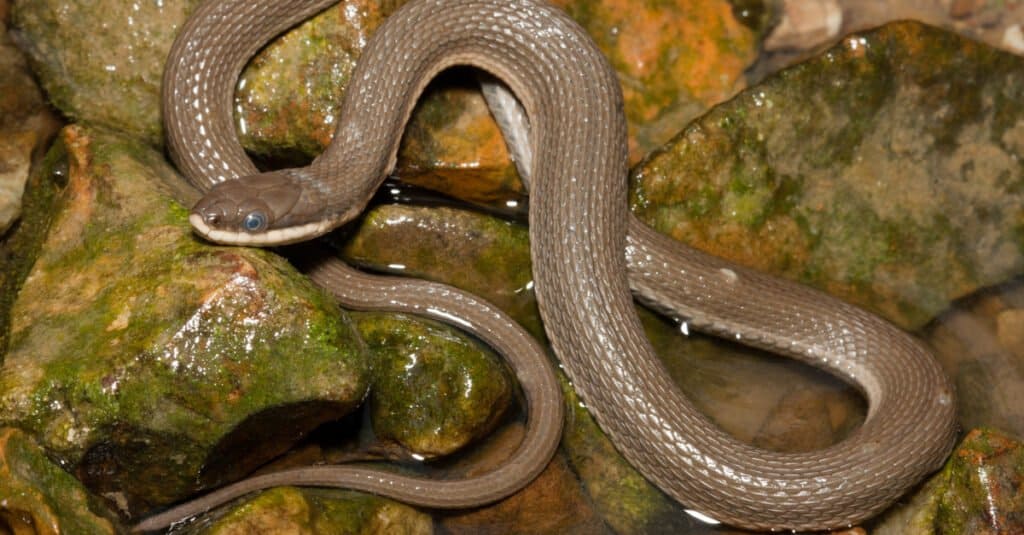
Queen snakes inhabit rocky-bottomed streams.
©Nathan A Shepard/Shutterstock.com
The final snake on the list is the queen snake which is a species of special concern within the state. They inhabit rocky-bottomed streams in scattered locations across the southern region of the state. They prey predominantly on freshly molted crayfish and possess a set up of unique adaptations to help them while hunting. First, they have a distinctly flattened head which allows them to reach underneath rocks more easily. They also have large, plate-like scales on the top of their head and underneath their chin to protect them from the sharp rocks. Queen snakes are 15 to 24 inches long and are typically dark brown with yellow stripes on their first row of scales. They also have several dark stripes on their upper side, although these are more visible when the snake is younger.
Summary of the 7 Water Snakes Lurking in Michigan Waters
| Snake | Danger Level | |
|---|---|---|
| 1 | Copperbelly Water Snake | Nonvenomous |
| 2 | Northern Water Snake | Nonvenomous but bites contain an anticoagulant that causes severe bleeding |
| 3 | Butler’s Garter Snake | Mildly venomous |
| 4 | Common Garter Snake | Mildly venomous saliva |
| 5 | Eastern Ribbon Snake | Nonvenomous |
| 6 | Kirtland’s Snake | Nonvenomous |
| 7 | Queen Snake | Nonvenomous but will spray a fowl-smelling musk when threatened |
The photo featured at the top of this post is © Jason Patrick Ross/Shutterstock.com
Discover the "Monster" Snake 5X Bigger than an Anaconda
Every day A-Z Animals sends out some of the most incredible facts in the world from our free newsletter. Want to discover the 10 most beautiful snakes in the world, a "snake island" where you're never more than 3 feet from danger, or a "monster" snake 5X larger than an anaconda? Then sign up right now and you'll start receiving our daily newsletter absolutely free.
Thank you for reading! Have some feedback for us? Contact the AZ Animals editorial team.






